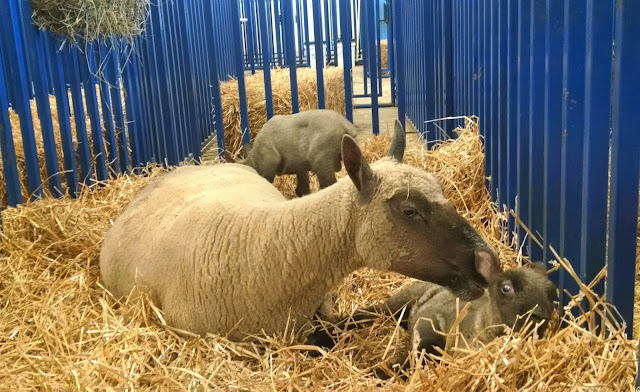While not in the breed barn, these lovely Karakul sheep from Pine Lane Farm made a nice display. These are youngsters but already show beautiful fleeces and breed type.
And of course a significant part of the festival is the competitive showing of the various breeds and categories of sheep. One could argue that the show ring puts pressure on breeders to select for traits that impress judges rather than always trying to meet a perfect balance of desired breed standards and productivity but in a venue like the Maryland Sheep and Wool Festival it may be most important that a given breed gets exposure to potential new shepherds. Many people contemplating sheep don't get to see representatives of a breed they are considering except for shows such as this and certainly not in these numbers. The right breed for your farm plan, the right fiber for your project - at this festival you will likely find options you didn't even know existed.
How do sheep shows work? Within each breed, classes are broken into genders (rams usually show first) and within each gender there are classes by age - yearlings, senior lambs and junior lambs. In each class animals are placed first, second, third, etc. When classes in each gender are concluded the first and second place animals for each class come back to be judged against each other for Champion Ram (or Ewe). It's possible for a younger animal to be a better specimen than an older one, so you could have the first place senior ram lamb named Champion and the first place yearling ram named Reserve Champion. It sounds confusing but it's quite orderly once you watch the process for a while.
The big show pavilion at Maryland is divided into two rings and so two breeds' shows can be going on at once. It can be a challenge for shepherds if they are showing more than one breed since they could need to be in both rings at once! This is where sheepy friends step in and help show animals when there just aren't enough hands to be everywhere at once. I've found sheep producers to be really generous this way - it's a competitive situation but we are all in it together so everyone helps when needed.
Pens around the show ring area are used to hold animals while they wait for their class to occur. If one has eight or ten sheep in a breed show it doesn't make sense to keep running back to their barn through throngs of people to swap entries.
These sheep are waiting for their classes in the Black Romney show ('black' meaning colored/not white).
I'm always happy to see so many kids involved with showing sheep. Having grown up on a farm I am probably biased but I think that you learn a great many things handling animals that you just don't grasp no matter how earnest and involved your parents and school teachers are. It takes a degree of patience, empathy and responsibility that you don't acquire unless live animals are involved. I was particularly taken with this little girl in the white shirt and tiara (who I later found out was six years old) and her confident manner. I had seen her earlier handling a white Romney who was pretty rowdy and actually knocked the child back onto her butt. She had never let go of the halter, popped back up like nothing happened, didn't get flustered or mad at the animal, just took it in stride and carried on.
In this case she is both watching the judge and checking to see how her lamb is standing compared to the nearest competitor. An adult is setting the lamb's back feet for her but then steps back and lets the child do the showing. Kids like this will grow up to be confident adults who achieve much.
This is what it's like to sit in the stands and watch. The White Romney show is in the near ring. The far ring holds Black Lincolns.























































